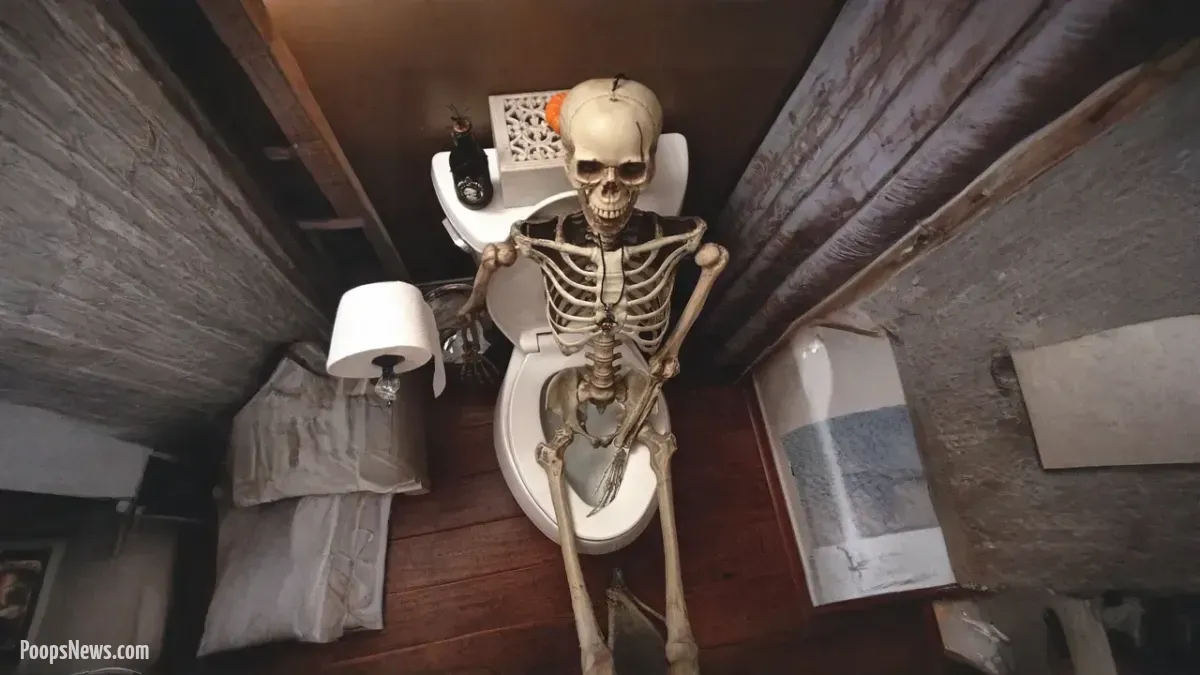In a stunning turn of events that has sent shockwaves through the scientific community, a group of esteemed British scientists has secured a groundbreaking grant of £5,500,000 to answer the age-old question: “Why don’t skeletons go to the toilet?” While some in the scientific world have hailed this as a monumental leap forward in human knowledge, others are left scratching their heads, wondering if this is a brilliant breakthrough or a grandiose waste of time, money, and — most importantly — common sense.
The Beginning of the Skeletal Saga
It all started on a crisp morning in early autumn when the United Kingdom’s prestigious National Science and Innovation Fund (NSIF) announced that it had awarded millions to a group of top-tier academics. Their mission? To explore the deeply profound and, apparently, uncharted territory of why skeletons — those marvels of calcium and cartilage — never seem to be seen queuing outside public restrooms.
For years, scientists have made important discoveries that have altered the course of human history. Newton’s laws of motion, Darwin’s theory of evolution, the understanding of black holes — these were all worthy endeavors. But this? The question of whether a pile of bones should require a bathroom break has stirred more than just intellectual curiosity. It’s stirred up controversy of the highest order.
Dr. Horace P. Fotheringay, the lead scientist on the project, addressed a skeptical press corps with confidence that bordered on messianic fervor. “This is the kind of question that keeps you up at night. It’s not just about skeletons — it’s about the very fabric of our understanding of bodily functions. Or lack thereof”, he declared, waving his glasses like a conductor leading an orchestra of baffled journalists.
The Scientific Rationale (If You Can Call It That)
Many of us have grown up with a particular image of skeletons — most notably from our annual Halloween festivities. They hang from doorframes, dance around in animated films, and, more importantly, never ask for a break to visit the loo. This curious phenomenon has puzzled generations of scientists, with most assuming that skeletons, being, well, devoid of any working organs, might not have the same biological urges as the rest of us flesh-bound folk. And yet, Dr. Fotheringay and his team believed otherwise.
“Our hypothesis is simple”, Fotheringay stated, adjusting his lab coat with the seriousness of a man discussing quantum mechanics. “Skeletons don’t go to the toilet because their gastrointestinal system, if they ever had one, has decayed beyond recognition. But — and here’s the crucial part — we can’t rule out the possibility that they’ve simply evolved beyond the need for such primitive bodily functions. This could be a case of post-digestive transcendence”.
The phrase “post-digestive transcendence” has since entered the lexicon of the general public, much to the confusion of biology teachers and Wikipedia editors alike.
A Public Divided: Is This Science or Satire?
The announcement of the grant sparked an immediate response from the scientific community and beyond. Twitter exploded with hashtags like #ToiletGate, #SkeletalWaste, and the ever-popular #FlushTheFunds. Television pundits debated the merits of the study with a gravity usually reserved for geopolitical crises.
Sir Nigel Bottomley, a noted critic of the project and head of the Society for Responsible Funding in Science, spoke out in a rare public statement: “To spend five and a half million pounds on determining why skeletal remains aren’t visiting the lavatory is a travesty. At best, it’s an embarrassing footnote in the annals of British science. At worst, it’s a national scandal that brings shame upon the institution of research”.
To counter the backlash, Dr. Fotheringay’s team launched an outreach campaign that included public lectures, a TED Talk titled “Bones: Nature’s Forgotten Innovators”, and a viral TikTok video where a dancing skeleton appeared to perform complex calculus while holding a miniature toilet plunger. The outreach campaign was, predictably, met with both applause and jeers.
Fieldwork of the Undead: Examining Skeletons in Their “Natural” Habitat
To prove their hypothesis, the team has planned a series of field studies. These studies, funded by taxpayer money, will include the examination of skeletons in a variety of “environments”, including graveyards, ossuaries, and — perhaps most ambitiously — those scattered on battlefields of ancient wars. It is here, the team believes, they will find crucial evidence as to why none of these bony figures seem preoccupied with visiting the lavatory.
“We plan to observe skeletal remains in situ, analyzing the wear and tear on the pelvic bones, the position of the femur, and — most importantly — the state of the teeth, which may give us clues as to whether they once ingested food that would’ve required… disposal”, said Dr. Matilda Grimshaw, a junior researcher on the team.
What exactly the team hopes to uncover remains unclear, but rumors have surfaced that they plan to use cutting-edge AI technology to simulate what a skeleton’s digestive system might have looked like, provided it was ever there. “It’s speculative work, yes”, Grimshaw admitted in a candid moment. “But the future of skeleton science is wide open”.
Skeletal Toilets of History: A Hidden Past?
Theories abound regarding why skeletons, in life or death, do not use restrooms. Some archaeologists speculate that ancient skeletons may have had access to facilities that have simply not survived the ravages of time. “We must consider the possibility that skeletons had restrooms. It’s just that we haven’t found any evidence yet because, much like their flesh, these structures have decayed”, said Professor Gwendolyn Starkweather, an archaeologist with a penchant for creative interpretations of history.
Historians, on the other hand, are less enthusiastic. “This project is built on a flimsy premise”, argued Dr. Gerald Toilette, a historian specializing in early Roman plumbing systems. “Skeletons were never meant to be studied for their bathroom habits. In life, they were people, yes, but in death, they’re simply bones. To suggest otherwise is to misunderstand both human biology and basic logic”.
The debate has even sparked philosophical musings. One particularly enthusiastic undergraduate at the University of Oxford penned a now-viral essay titled “I Think, Therefore I Don’t Pee: A Cartesian Analysis of Skeletal Autonomy”, which has since been picked up by several prestigious academic journals.
The Future of Skeletal Research: Flushing Out the Truth
As the grant money begins to flow, the team has plans to expand their research into even more esoteric areas of study. Rumor has it they’ve submitted additional funding proposals to investigate whether ghosts leave footprints and if vampires prefer bidets. “There are many questions left unanswered”, said Fotheringay with an air of both defiance and a kind of gleeful delusion.
“This isn’t just about skeletons and toilets. This is about confronting the uncomfortable truths that science has been too afraid to tackle for centuries. If we can crack this case wide open, who knows what other bodily mysteries we’ll be able to solve?”
A Nation Waits
As the public watches this saga unfold, one can only wonder where it will all end. Will Dr. Fotheringay and his team manage to uncover the hidden truths about skeletons and their supposed toilet habits? Or will this endeavor go down in history as one of the most expensive — and absurd — scientific failures of all time?
Only time, and perhaps a very large toilet plunger, will tell.





